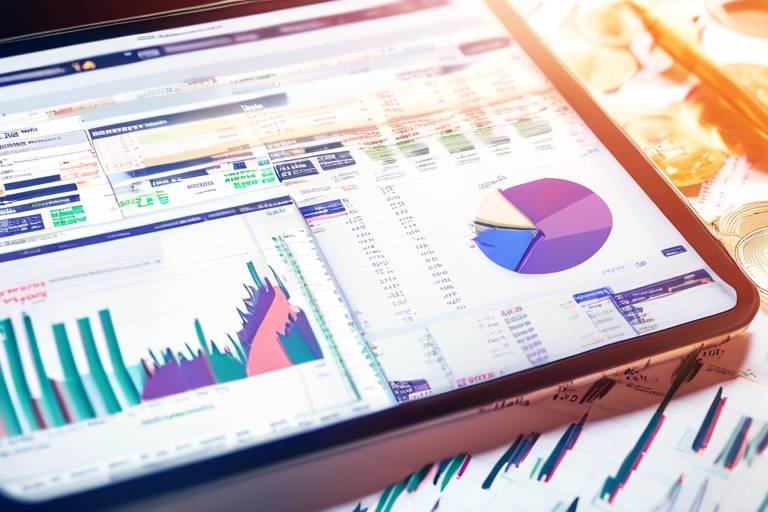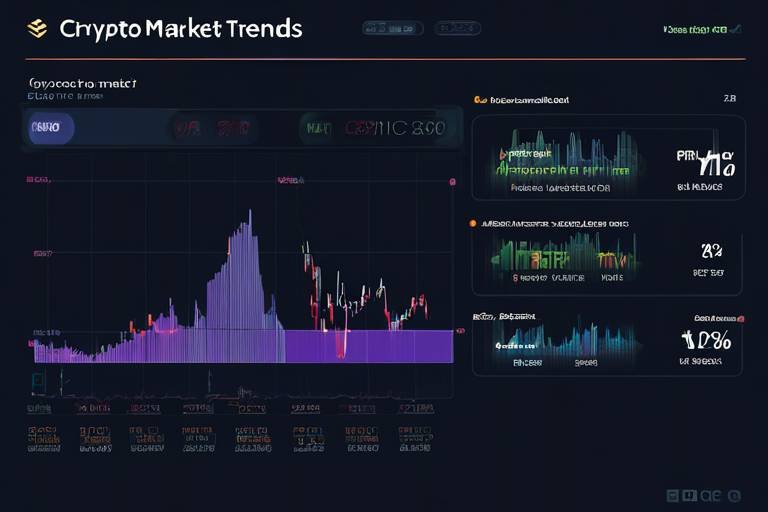How to Create a Winning Trading Plan
Creating a successful trading plan is not just about making trades; it's about establishing a roadmap that guides your decisions and actions in the financial markets. Think of it like a treasure map that leads you to your financial goals, helping you navigate the often turbulent waters of trading. Without a solid plan, traders can easily drift into the chaos of emotional decision-making and impulsive trades, which often lead to losses. Therefore, a well-structured trading plan is essential for anyone serious about trading. It encompasses everything from your trading goals to your risk management strategies, and even your psychological preparedness. So, let’s dive into the essential components that will help you craft a winning trading plan that not only aligns with your financial aspirations but also equips you with the tools to handle the ups and downs of the market.
Defining clear and achievable trading goals is crucial. Imagine trying to hit a target without knowing where it is; that's what trading is like without specific goals. To set effective goals, consider using the SMART criteria, which stands for Specific, Measurable, Attainable, Relevant, and Time-bound. For instance, instead of saying, "I want to make money trading," you might say, "I aim to achieve a 15% return on my trading account within the next six months." This clarity will help you focus your efforts and measure your progress over time.
Effective market analysis is fundamental to a trading plan. Without understanding market movements, your trades are akin to throwing darts blindfolded. There are two primary types of analysis: technical and fundamental. Technical analysis involves studying price charts and patterns to predict future movements, while fundamental analysis focuses on understanding the economic factors that drive market prices. Both methods are crucial for making informed trading decisions and can significantly impact your success.
Technical analysis is like learning the language of the market. By studying price charts and patterns, you can gain insights into potential future movements. Traders often rely on various indicators and tools to identify entry and exit points. Some key indicators include:
- Moving Averages: These help smooth out price data to identify trends over a specific period.
- Relative Strength Index (RSI): This momentum oscillator measures the speed and change of price movements.
- Moving Average Convergence Divergence (MACD): This trend-following momentum indicator shows the relationship between two moving averages of a security's price.
Recognizing chart patterns can provide insights into market trends. Patterns like head and shoulders, triangles, and flags can signal potential reversals or continuations in price movements. For example, a head and shoulders pattern often indicates that a bullish trend may be reversing, while a triangle pattern can suggest that the market is consolidating before a breakout. Understanding these patterns can give you a significant edge in your trading strategy.
Indicators and oscillators are essential tools in technical analysis. They help traders gauge market momentum and make informed decisions. For instance, the Moving Average can help you identify the overall trend direction, while the RSI can signal overbought or oversold conditions. By combining these tools, traders can develop a more robust strategy that accounts for market behavior.
While technical analysis focuses on price movements, fundamental analysis digs deeper into the economic factors that influence market prices. This includes examining news releases, earnings reports, and economic indicators such as GDP growth, unemployment rates, and inflation. For example, a strong earnings report from a company can lead to a surge in its stock price, while negative economic news can trigger a market downturn. By staying informed about these factors, traders can make more strategic decisions.
Risk management is vital for long-term success in trading. It's like having a safety net that protects you from the inevitable ups and downs of the market. Without proper risk management, even the best trading strategy can lead to significant losses. Some effective strategies include position sizing and risk-reward ratios, which help you determine how much of your capital to risk on each trade.
Determining the right position size is crucial for managing risk effectively. Various methods can be employed, such as the fixed percentage model, where you risk a certain percentage of your trading capital on each trade, or the Kelly Criterion, which calculates the optimal bet size based on your win rate and payout ratio. By using these techniques, you can allocate your capital wisely and minimize potential losses.
Stop-loss orders are essential for limiting potential losses. They act as a safety net, automatically closing your position when the market moves against you. Setting stop-loss levels based on market volatility and your individual risk tolerance can protect your capital and help you stay in the game longer. For instance, if you're trading a highly volatile stock, you may want to set a wider stop-loss to avoid being stopped out prematurely.
Discipline is key to executing a trading plan successfully. It’s easy to get caught up in the excitement of the market, but sticking to your plan is crucial for long-term success. Managing emotions and avoiding impulsive decisions can be challenging, but it’s essential for maintaining consistency in your trading approach.
Managing emotions is critical in trading. Techniques like mindfulness and journaling can help traders maintain focus and make rational decisions. By reflecting on your trades and understanding your emotional triggers, you can develop a more disciplined approach to trading. For instance, keeping a trading journal allows you to analyze your decisions and learn from your mistakes, ultimately improving your trading performance.
Regularly reviewing and adjusting your trading plan is essential for improvement. Just like a ship needs to adjust its course to reach its destination, traders must assess their performance and make necessary changes to stay aligned with their goals. This could involve analyzing past trades, evaluating market conditions, or even setting new goals based on your evolving trading experience.
1. What is the most important part of a trading plan?
The most critical part of a trading plan is defining your trading goals. Without clear objectives, it’s challenging to measure success and make informed decisions.
2. How often should I review my trading plan?
It’s advisable to review your trading plan regularly, at least once a month, to assess your performance and make necessary adjustments based on market conditions and personal growth.
3. Can I trade without a plan?
While it’s possible to trade without a plan, doing so increases the risk of emotional decision-making and potential losses. A well-structured plan minimizes these risks and guides your trading actions.
4. How do I manage my emotions while trading?
Techniques such as mindfulness, journaling, and setting clear rules can help manage emotions. Staying disciplined and sticking to your trading plan is crucial for making rational decisions.

Understanding Your Trading Goals
Defining clear and achievable trading goals is crucial for any trader looking to navigate the often turbulent waters of the financial markets. Without a well-defined goal, you're essentially sailing without a compass, and we all know how that can end! So, how do you set yourself up for success? One effective method is to utilize the SMART criteria, which stands for Specific, Measurable, Attainable, Relevant, and Time-bound objectives. This framework not only helps you clarify your goals but also keeps you accountable as you progress on your trading journey.
Let's break it down a bit further. When you set Specific goals, you’re not just saying, "I want to make money." Instead, you might say, "I want to make $1,000 in the next three months by trading stocks." This level of specificity gives you a clear target to aim for. Next, your goals should be Measurable. This means you should be able to track your progress. For instance, if your goal is to increase your trading account by 20%, you can easily measure how close you are to that figure.
Now, let’s talk about Attainable. It’s essential to set goals that are challenging yet realistic. If you’re a beginner, aiming to double your account in a month might not be feasible. Instead, focus on smaller, achievable milestones that can build your confidence and skills over time. Then there’s Relevant. Your goals should align with your broader financial objectives and personal circumstances. If you’re trading part-time while holding down a full-time job, your goals should reflect the time and resources you can realistically dedicate to trading.
Finally, your goals need to be Time-bound. Setting a deadline creates a sense of urgency and helps you stay focused. For example, instead of saying, "I want to learn technical analysis," you could say, "I want to complete an online course on technical analysis by the end of this month." This gives you a clear timeline to work with.
In summary, crafting your trading goals using the SMART criteria can significantly enhance your trading experience. It’s like having a roadmap that guides you through the complexities of the market, helping you stay on track and avoid unnecessary detours. Remember, the journey of a thousand trades begins with a single goal!
To further illustrate the importance of setting SMART goals, consider the following table:
| SMART Criteria | Example |
|---|---|
| Specific | Make $1,000 in three months |
| Measurable | Increase trading account by 20% |
| Attainable | Achieve 5% monthly returns |
| Relevant | Align with long-term financial goals |
| Time-bound | Complete a trading course by the end of the month |
By following these principles, you can ensure that your trading goals are not just dreams but actionable steps that lead you toward success. So, what are you waiting for? Start defining your trading goals today!

Market Analysis Techniques
When it comes to trading, understanding the market is like having a map in a foreign land. Without it, you might find yourself lost, wandering aimlessly, and missing out on lucrative opportunities. Market analysis techniques are the tools that help traders navigate the complex world of financial markets. They can be broadly categorized into two main approaches: technical analysis and fundamental analysis. Each method has its unique strengths and can be used in tandem to create a comprehensive trading strategy.
Technical analysis is all about the numbers, charts, and patterns. It focuses on historical price movements and trading volumes to predict future market behavior. Traders who swear by this method believe that all relevant information is already reflected in the price. By studying price charts, they can identify trends and potential reversal points. For instance, a trader might look for certain chart patterns that have historically indicated a bullish or bearish trend. Some common patterns include:
- Head and Shoulders: This pattern often signals a reversal in trend.
- Triangles: These can indicate continuation or reversal depending on their formation.
- Flags: Typically represent a brief consolidation before the previous trend resumes.
In addition to chart patterns, traders utilize various indicators and oscillators to gauge market momentum. Tools like Moving Averages, Relative Strength Index (RSI), and Moving Average Convergence Divergence (MACD) can provide insights into whether a market is overbought or oversold. For example, if the RSI value is above 70, it might suggest that the asset is overbought, indicating a potential price correction.
On the flip side, fundamental analysis digs deeper into the underlying factors that drive market prices. It examines economic indicators, company earnings reports, and geopolitical events to understand how they impact supply and demand. For instance, if a company reports higher-than-expected earnings, its stock price may surge. Similarly, economic indicators such as GDP growth, unemployment rates, and inflation can significantly influence market sentiment.
Both technical and fundamental analyses have their merits, and savvy traders often blend the two to form a well-rounded perspective. Imagine you're a chef; you wouldn't rely on just one ingredient to create a delicious dish. Similarly, using both analysis methods allows you to make more informed trading decisions, enhancing your chances of success.
So, how do you effectively combine these two approaches? One common strategy is to start with fundamental analysis to identify potential trading opportunities. Once you have a list of promising assets, you can then apply technical analysis to pinpoint the best entry and exit points. This two-pronged approach not only helps in identifying potential trades but also in managing risks effectively.
In conclusion, mastering market analysis techniques is essential for any trader looking to thrive in the financial markets. Whether you lean towards technical analysis, fundamental analysis, or a combination of both, the key is to stay informed and adaptable. The market is constantly evolving, and so should your strategies.
Q: What is the difference between technical and fundamental analysis?
A: Technical analysis focuses on price movements and patterns, while fundamental analysis examines economic factors and news events that influence market prices.
Q: Can I rely solely on one type of analysis?
A: While some traders prefer one method, combining both technical and fundamental analysis often yields better results by providing a comprehensive view of the market.
Q: How often should I review my trading strategy?
A: Regularly reviewing and adjusting your trading strategy is crucial. It’s recommended to assess your performance at least monthly to stay aligned with your trading goals.

Technical Analysis Basics
When diving into the world of trading, technical analysis is like having a treasure map that guides you through the often turbulent seas of the financial markets. At its core, technical analysis involves examining price charts and historical data to predict future price movements. Think of it as a detective work where every price movement tells a story, and your job is to decipher it. Traders use various tools and indicators to help them make informed decisions, and understanding these elements is crucial for anyone looking to enhance their trading skills.
One of the primary tools in technical analysis is price charts. These charts visually represent the price movements of a particular asset over time, allowing traders to spot trends and patterns. The most common types of charts include line charts, bar charts, and candlestick charts. Each has its unique way of displaying price action, but candlestick charts are particularly popular due to the wealth of information they provide in a single glance. They can show not just the opening and closing prices but also the highs and lows during a specific time frame, helping traders to understand market sentiment better.
In addition to charts, traders rely on indicators to quantify market behavior. These indicators can be classified into two main categories: trend indicators and momentum indicators. Trend indicators, such as Moving Averages, help traders identify the direction of the market, while momentum indicators, like the Relative Strength Index (RSI) and the Moving Average Convergence Divergence (MACD), measure the speed of price changes. By combining different indicators, traders can create a more comprehensive view of market conditions.
To illustrate the importance of these tools, consider the following table that outlines some popular indicators and their uses:
| Indicator | Type | Purpose |
|---|---|---|
| Moving Average | Trend | Smooths price data to identify the direction of the trend. |
| Relative Strength Index (RSI) | Momentum | Measures the speed and change of price movements to identify overbought or oversold conditions. |
| MACD | Momentum | Indicates the relationship between two moving averages of a security's price. |
Moreover, chart patterns play a significant role in technical analysis. Recognizing these patterns can give traders a heads-up about potential market movements. For example, patterns like head and shoulders, triangles, and flags can signal reversals or continuations in trends. Understanding these patterns is akin to reading the mood of the market, allowing traders to make timely and strategic decisions.
In summary, mastering the basics of technical analysis is essential for any trader aiming to navigate the complexities of the financial markets. By effectively utilizing price charts, indicators, and chart patterns, traders can enhance their decision-making process and increase their chances of success. Remember, the market is full of surprises, and having a solid grasp of technical analysis can be your best ally in seizing opportunities when they arise.
- What is technical analysis? Technical analysis is the study of past market data, primarily price and volume, to forecast future price movements.
- How do I read a candlestick chart? A candlestick chart displays the open, high, low, and close prices for a specific time period, with each 'candlestick' representing this data visually.
- What are the most common technical indicators? Some of the most common indicators include Moving Averages, RSI, and MACD.
- Can technical analysis guarantee profits? While technical analysis can improve your chances of making informed decisions, it does not guarantee profits as the market is inherently unpredictable.

Chart Patterns
Chart patterns are the visual representations of price movements that can provide traders with valuable insights into future market behavior. Understanding these patterns is like having a roadmap that guides you through the often unpredictable terrain of trading. Just as a seasoned traveler knows to look for landmarks, traders should learn to recognize specific patterns that indicate potential price movements. These patterns can signal whether the market is likely to continue in its current direction or reverse its course.
Among the most commonly recognized chart patterns are the head and shoulders, triangles, and flags. Each of these patterns tells a unique story about market sentiment and potential future movements. For instance, a head and shoulders pattern typically indicates a reversal from bullish to bearish, making it a crucial pattern for traders to watch. On the other hand, triangles can signal continuation or reversal depending on their formation and breakout direction.
To illustrate the significance of these patterns, consider the following table that summarizes some key chart patterns along with their implications:
| Chart Pattern | Description | Implication |
|---|---|---|
| Head and Shoulders | A peak (head) between two lower peaks (shoulders). | Potential bearish reversal. |
| Inverse Head and Shoulders | A trough (head) between two higher troughs (shoulders). | Potential bullish reversal. |
| Triangles | Converging trendlines that can be ascending, descending, or symmetrical. | Indicates a continuation or reversal based on breakout direction. |
| Flags | Small rectangular shapes that slope against the prevailing trend. | Continuation pattern indicating a brief consolidation before the trend resumes. |
Recognizing these patterns is not just about memorization; it requires practice and a keen eye for detail. Traders often use tools such as trend lines and volume analysis to confirm the signals provided by chart patterns. For example, a breakout from a triangle pattern accompanied by high volume can be a strong indicator of the market's next move.
In conclusion, mastering chart patterns is an essential skill for any trader looking to enhance their trading strategy. By learning to identify these patterns and understanding their implications, traders can improve their decision-making process and increase their chances of success in the market. So, the next time you sit down to analyze a chart, remember that these patterns are more than just shapes—they're clues that can lead you to profitable trades.
- What is a chart pattern? A chart pattern is a recognizable formation created by the price movements of a security on a chart, which can indicate potential future price movements.
- How can I identify chart patterns? You can identify chart patterns by analyzing price charts and looking for specific formations such as head and shoulders, triangles, and flags.
- Are chart patterns reliable? While chart patterns can provide valuable insights, they are not foolproof. It's essential to use them in conjunction with other analysis methods and risk management strategies.
- How do I practice identifying chart patterns? You can practice by analyzing historical price charts, using demo trading accounts, and studying educational resources focused on technical analysis.

Indicators and Oscillators
When it comes to trading, understanding the market's pulse is essential, and this is where indicators and oscillators come into play. These tools serve as the trader's compass, guiding decisions by analyzing price movements and market momentum. Think of indicators as the weather forecast for trading; they help you predict whether the market will be sunny and bullish or stormy and bearish. By leveraging these tools, traders can make informed decisions about when to enter or exit a trade, ultimately enhancing their chances of success.
Indicators are typically derived from price and volume data, providing visual representations that simplify complex market information. Some of the most widely used indicators include Moving Averages, Relative Strength Index (RSI), and Moving Average Convergence Divergence (MACD). Each of these indicators has its unique function and can be used in various trading strategies. For instance, Moving Averages smooth out price data to help identify trends, while RSI measures the speed and change of price movements to determine overbought or oversold conditions.
Oscillators, on the other hand, are a subset of indicators that fluctuate between a defined range, usually between 0 and 100. They are particularly useful in identifying potential reversal points in the market. A popular example is the Stochastic Oscillator, which compares a particular closing price of a security to a range of its prices over a certain period. This can help traders pinpoint moments when a stock might be overbought or oversold, offering opportunities for profitable trades.
It's essential to understand how to interpret these indicators and oscillators effectively. For example, a trader might use a combination of RSI and MACD to confirm a trading signal. If the RSI indicates that a stock is overbought while the MACD shows a bearish crossover, this could be a strong signal to consider selling. Conversely, if both indicators suggest a bullish trend, it might be wise to enter a position.
In practice, many traders develop a personalized strategy that incorporates multiple indicators and oscillators to create a comprehensive market analysis. This approach can lead to more robust trading decisions, as it allows for cross-verification of signals. However, it's crucial to remember that no indicator is foolproof. They should be used in conjunction with other forms of analysis and risk management strategies to ensure a balanced trading plan.
To illustrate the differences between some common indicators and oscillators, here's a simple comparison table:
| Type | Name | Function |
|---|---|---|
| Indicator | Moving Average | Identifies trend direction by smoothing price data. |
| Indicator | MACD | Shows the relationship between two moving averages of a security’s price. |
| Oscillator | RSI | Measures the speed and change of price movements to identify overbought or oversold conditions. |
| Oscillator | Stochastic Oscillator | Compares a security's closing price to its price range over a specific period. |
In conclusion, mastering indicators and oscillators is a vital step in becoming a proficient trader. By understanding how to utilize these tools effectively, you can gain deeper insights into market trends and enhance your trading strategies. Remember, the key is to combine these tools with your trading plan and risk management strategies for the best results.

Fundamental Analysis Essentials
When diving into the world of trading, understanding fundamental analysis is like having a map in uncharted territory. It focuses on the underlying economic factors that influence market prices, offering traders a comprehensive view of the market landscape. By analyzing these factors, traders can make informed decisions that align with their financial goals. So, what exactly should you be looking at?
At the core of fundamental analysis are several key components that can impact the price of assets. These include economic indicators, news releases, and corporate earnings reports. Each of these elements can sway market sentiment, causing prices to fluctuate. For instance, a strong jobs report can lead to bullish market behavior, while disappointing earnings from a major corporation might trigger a sell-off.
To illustrate the importance of these factors, let's consider a few common economic indicators:
| Indicator | Description | Impact on Trading |
|---|---|---|
| Gross Domestic Product (GDP) | Measures the overall economic output of a country. | A strong GDP growth can lead to increased investor confidence. |
| Consumer Price Index (CPI) | Tracks changes in the price level of a basket of consumer goods and services. | High inflation rates can lead to central banks raising interest rates. |
| Employment Data | Includes unemployment rates and job creation figures. | Strong employment data often correlates with economic growth. |
News releases are another critical aspect of fundamental analysis. Traders need to stay updated on global events, financial news, and geopolitical developments. For example, a sudden political upheaval in a key oil-producing country could lead to a spike in oil prices. Therefore, keeping an eye on the news is essential for traders who want to anticipate market movements.
Additionally, earnings reports from publicly traded companies can significantly impact stock prices. These reports provide insights into a company's profitability and future outlook. Positive earnings can boost stock prices, while negative surprises can lead to sharp declines. Traders must analyze these reports carefully, considering not just the numbers but also the context surrounding them.
In conclusion, mastering fundamental analysis is crucial for any trader looking to succeed in the markets. By understanding economic indicators, staying informed about news, and analyzing corporate earnings, traders can make more educated decisions. This knowledge not only enhances their trading strategies but also builds the confidence needed to navigate the often volatile trading environment.
- What is the difference between technical and fundamental analysis?
Technical analysis focuses on price movements and chart patterns, while fundamental analysis examines the economic factors that influence asset prices. - How often should I review economic indicators?
It's essential to keep an eye on economic indicators regularly, especially around significant news releases or economic reports. - Can fundamental analysis guarantee successful trades?
No analysis can guarantee success, but understanding fundamental factors can significantly improve your decision-making process.

Risk Management Strategies
When it comes to trading, one of the most crucial aspects that can determine your success is risk management. Think of it as your financial safety net, designed to protect your hard-earned money from the unpredictable waves of the market. Just like a lifeguard keeps a watchful eye on swimmers, you need to be vigilant about your risk exposure. Without proper risk management, even the most skilled traders can find themselves in deep waters, facing significant losses that could derail their trading journey.
One of the first steps in effective risk management is understanding the concept of position sizing. This refers to how much of your capital you allocate to a single trade. It’s essential to strike a balance; you want to invest enough to make meaningful profits, but not so much that a single loss could wipe out a significant portion of your account. A common rule of thumb is to risk no more than 1% to 2% of your trading capital on any single trade. This way, even a string of losses won’t cripple your account.
To illustrate this further, let’s consider a hypothetical scenario. If you have a trading account of $10,000 and decide to risk 2% on each trade, your maximum loss per trade would be $200. This approach allows you to endure multiple losses without devastating your portfolio, ultimately giving you the opportunity to recover and continue trading.
Another critical aspect of risk management is the use of stop-loss orders. These are predetermined price levels at which you will exit a trade to prevent further losses. Setting stop-loss orders is like having a fire extinguisher handy; it may not prevent the fire, but it can certainly minimize the damage. To effectively set stop-loss levels, consider factors such as market volatility and your personal risk tolerance. For instance, in a highly volatile market, you might want to set a wider stop-loss to avoid being prematurely stopped out of a trade due to normal price fluctuations.
Moreover, understanding the risk-reward ratio is essential in your trading plan. This ratio helps you assess whether the potential reward of a trade justifies the risk you are taking. A common target is a risk-reward ratio of at least 1:2, meaning for every dollar you risk, you aim to make two. It’s like betting on a horse; if you’re going to place a bet, you want to ensure that the payout is worth the risk. This strategy not only helps in maximizing profits but also ensures that even if you lose more trades than you win, you can still come out ahead financially.
In summary, effective risk management strategies involve a combination of position sizing, stop-loss orders, and understanding your risk-reward ratio. By implementing these strategies, you can significantly enhance your trading performance and protect your capital from unforeseen market movements. Remember, trading is not just about making money; it’s also about preserving what you have, allowing you to trade another day.
- What is the best way to manage risk in trading? The best way to manage risk is through proper position sizing, setting stop-loss orders, and understanding your risk-reward ratio.
- How much of my capital should I risk on a single trade? It's generally recommended to risk no more than 1% to 2% of your trading capital on any single trade.
- What is a stop-loss order? A stop-loss order is a predetermined price level at which you exit a trade to prevent further losses.
- What is a good risk-reward ratio? A common target is a risk-reward ratio of at least 1:2, meaning for every dollar you risk, you aim to make two.

Position Sizing Techniques
When it comes to trading, one of the most critical components of your strategy is position sizing. It’s not just about how much you can potentially gain; it’s equally important to consider how much you’re willing to risk on each trade. Think of it like a game of poker: you wouldn’t bet your entire stack on a single hand, right? Similarly, in trading, you need to determine the size of each position based on your overall capital and risk tolerance.
One effective method for determining your position size is the fixed percentage model. This technique involves risking a predetermined percentage of your trading capital on each trade. For instance, if your trading account has $10,000 and you decide to risk 2% per trade, you would set your maximum risk to $200. This way, regardless of your account balance fluctuations, you maintain a consistent risk level. But how do you calculate this in practice? Here’s a simple formula:
| Account Balance | Risk Percentage | Maximum Risk |
|---|---|---|
| $10,000 | 2% | $200 |
Another popular approach is the Kelly Criterion. This method helps you determine the optimal size of your positions based on the probability of winning and the potential payout. While it can be a bit more complex, the formula essentially tells you how much of your capital you should risk on a trade in order to maximize your growth over time. Here’s the formula in its simplest form:
Optimal Bet Size (bp - q) / b
Where:
- b odds received on the wager (i.e., your potential payout)
- p probability of winning
- q probability of losing (which is 1 - p)
It’s important to remember that while these techniques provide a structured approach to position sizing, they should be tailored to fit your personal trading style and risk tolerance. Not every trader will feel comfortable using the same percentage or method, and that’s perfectly okay. The key is to find what works best for you and stick with it as you develop your trading plan.
Lastly, always keep in mind that even the best strategies can’t eliminate risk entirely. Position sizing is just one piece of the puzzle. It’s essential to combine it with other risk management techniques, such as setting stop-loss orders, to ensure you’re protecting your capital effectively. By understanding and implementing proper position sizing techniques, you’ll be well on your way to becoming a more disciplined and successful trader.
1. What is position sizing in trading?
Position sizing refers to the amount of capital you allocate to a particular trade. It’s a crucial aspect of risk management that helps determine how much you can afford to lose on a trade without significantly impacting your overall capital.
2. How do I calculate my position size?
To calculate your position size, decide on a risk percentage (e.g., 1-3% of your capital) and use that to determine how much money you’re willing to lose on a trade. Use this information along with your entry and stop-loss levels to determine the number of shares or contracts to buy or sell.
3. Why is position sizing important?
Proper position sizing helps you manage risk and protect your trading capital. It ensures that no single trade can wipe out your account, allowing you to trade with confidence and discipline.
4. Can I use different position sizes for different trades?
Absolutely! You can adjust your position size based on your confidence in the trade, market conditions, or your personal risk tolerance. Just ensure that you maintain a consistent approach to avoid emotional decision-making.

Setting Stop-Loss Orders
Setting stop-loss orders is a fundamental aspect of any successful trading strategy. These orders act as a safety net, helping traders limit their potential losses in unpredictable market conditions. Imagine you're on a tightrope, and the wind starts to blow—your stop-loss is the harness that keeps you from falling. The key is to determine the right level for your stop-loss, which is influenced by various factors such as market volatility, your trading style, and individual risk tolerance.
When placing a stop-loss order, consider the following factors:
- Market Volatility: In highly volatile markets, prices can swing dramatically. Setting a stop-loss too close to your entry point may result in being stopped out prematurely. Conversely, placing it too far away can lead to larger losses than intended.
- Support and Resistance Levels: Identifying key support and resistance levels on your charts can help you determine logical stop-loss points. For instance, if you're buying a stock at $50 and there's strong support at $48, you might set your stop-loss just below that level.
- Personal Risk Tolerance: Everyone has a different comfort level when it comes to risk. A common approach is to set your stop-loss at a percentage of your total capital—many traders opt for 1-2% of their account balance. This ensures that no single trade can significantly impact your overall portfolio.
Additionally, it’s essential to regularly review and adjust your stop-loss orders as market conditions change. For instance, if a trade moves in your favor, you might want to "trail" your stop-loss, locking in profits while still allowing for some price fluctuations. This technique can be particularly useful in trending markets, as it helps protect gains without prematurely exiting a position.
In summary, setting stop-loss orders is not just a defensive maneuver; it’s a proactive strategy that allows traders to maintain control over their trading outcomes. By carefully considering where to place your stop-loss, you can navigate the markets with greater confidence and resilience, ultimately enhancing your trading performance.
Q: What is a stop-loss order?
A: A stop-loss order is an instruction to sell a security when it reaches a certain price, helping traders limit their losses.
Q: How do I determine where to set my stop-loss?
A: Consider market volatility, support and resistance levels, and your personal risk tolerance when setting your stop-loss.
Q: Can I adjust my stop-loss after placing it?
A: Yes, you can adjust your stop-loss order as market conditions change or as your trade moves in your favor.

Maintaining Trading Discipline
Discipline is the backbone of a successful trading journey. Without it, even the most meticulously crafted trading plan can fall apart like a house of cards. Picture this: you’ve done all the research, analyzed the charts, and set your goals. Yet, when the market starts to fluctuate, emotions can take the wheel, leading to impulsive decisions that can derail your progress. It's crucial to understand that trading is not just about numbers; it’s also about psychology.
To maintain discipline, you need to develop a strong mental framework. Think of your trading plan as a roadmap. If you veer off course, you risk losing sight of your destination. One effective way to keep yourself grounded is to create a set of rules that you adhere to without exception. These rules should cover aspects such as when to enter and exit trades, how much capital to risk, and how to respond to unexpected market movements. By having a clear set of guidelines, you can reduce the chances of making emotional decisions that could lead to losses.
Another powerful technique for maintaining discipline is emotional control. Emotions like fear and greed can cloud judgment and lead to rash actions. To combat this, many traders find it helpful to practice mindfulness techniques. Mindfulness encourages you to stay present and aware of your thoughts and feelings without letting them dictate your actions. Incorporating practices such as deep breathing or meditation can help you stay calm during volatile market conditions, allowing you to stick to your trading plan.
Additionally, keeping a trading journal can be a game-changer. Documenting your trades, the rationale behind your decisions, and your emotional state during trades can provide valuable insights into your trading habits. Over time, you'll begin to notice patterns in your behavior, which can help you identify triggers that lead to poor decision-making. By reflecting on these insights, you can adjust your approach and reinforce your discipline.
Finally, it’s essential to regularly review and adjust your trading plan. Markets are dynamic, and what worked yesterday may not work tomorrow. By evaluating your performance and making necessary changes, you’ll not only stay aligned with your goals but also cultivate a sense of accountability. This ongoing refinement process helps you remain disciplined and focused on your long-term objectives.
- What is trading discipline? Trading discipline refers to the ability to stick to your trading plan and rules without letting emotions interfere.
- How can I improve my trading discipline? You can improve your discipline by setting clear rules, practicing mindfulness, maintaining a trading journal, and regularly reviewing your performance.
- Why is emotional control important in trading? Emotional control helps prevent impulsive decisions that can lead to significant losses, allowing you to focus on your strategy instead.
- What should I include in my trading journal? Your trading journal should include details about your trades, your thought process, emotional state, and any lessons learned.

Emotional Control Techniques
When it comes to trading, emotional control is often the unsung hero of success. Imagine being on a roller coaster, where the highs and lows are exhilarating yet terrifying. Just like that ride, trading can evoke a whirlwind of emotions, from the thrill of a winning trade to the gut-wrenching anxiety of a loss. To navigate this tumultuous landscape, traders must adopt effective emotional control techniques that can help maintain focus and clarity under pressure.
One of the most effective methods for achieving emotional control is mindfulness. This technique encourages traders to remain present and fully engaged in the moment, rather than getting swept away by past losses or future uncertainties. Practicing mindfulness involves simple exercises such as deep breathing or meditation, which can ground your thoughts and allow you to make more rational decisions. Just take a moment to pause, breathe deeply, and remind yourself that every trade is a learning opportunity, not just a gamble.
Another invaluable tool is trading journaling. Keeping a journal of your trades, including your thought processes and emotional responses, can provide profound insights into your patterns and behaviors. By documenting your trades, you can identify triggers that lead to emotional reactions, whether it’s fear, greed, or overconfidence. This self-reflection allows you to adjust your strategies and responses, ensuring that your emotions do not dictate your trading decisions. Plus, it’s a great way to track your progress over time!
Here’s a quick overview of some emotional control techniques that can help you on your trading journey:
- Mindfulness Practices: Engage in meditation or deep breathing exercises to stay present.
- Trading Journals: Document your trades and emotions to identify patterns.
- Set Realistic Expectations: Understand that losses are part of the process; don’t let them derail your confidence.
- Limit Exposure: Set a maximum loss limit per day to prevent emotional trading.
Moreover, it’s essential to develop a support system. Surrounding yourself with other traders can provide a sense of community and accountability. Whether it’s through online forums, local trading groups, or social media, sharing experiences and strategies can help you gain perspective and reduce feelings of isolation. Remember, you’re not alone in this journey; many traders face similar emotional battles.
Lastly, take breaks when needed. Trading can be intense, and stepping away from the screen can help clear your mind. Whether it’s a short walk, engaging in a hobby, or simply taking a day off, allowing yourself that space can rejuvenate your mind and help you return with a fresh perspective. Just like a sprinter needs to rest between races, so do traders need to recharge to perform at their best.
In conclusion, mastering emotional control is not just about managing fear or excitement; it’s about creating a balanced mindset that allows you to navigate the markets with confidence. By incorporating mindfulness, journaling, building a support system, and knowing when to take breaks, you can transform your trading experience and enhance your decision-making capabilities. Remember, the journey of trading is as much about understanding yourself as it is about understanding the market.
- What is the importance of emotional control in trading? Emotional control helps traders make rational decisions, preventing impulsive trades driven by fear or greed.
- How can I practice mindfulness in trading? Techniques such as meditation, deep breathing, and focusing on the present moment can enhance mindfulness.
- What should I include in my trading journal? Document your trades, emotional responses, market conditions, and lessons learned for better self-awareness.
- Why is it beneficial to have a support system? A support system provides encouragement, accountability, and shared experiences, making the trading journey less isolating.

Reviewing and Adjusting Your Plan
In the fast-paced world of trading, the only constant is change. As a trader, it's essential to regularly review and adjust your trading plan to ensure it remains effective and aligned with your financial goals. Think of your trading plan as a living document—a roadmap that requires updates as you gain experience and as market conditions evolve. Just like a seasoned traveler checks their route to avoid detours, you must periodically assess your trading strategies to stay on the right path.
Start by conducting a thorough analysis of your past trades. What worked well? What didn't? This self-reflection is crucial for identifying patterns in your trading behavior. You might find that certain strategies yield better results under specific market conditions. Use this knowledge to refine your approach. For instance, if you notice that your trades are more successful during periods of high volatility, consider adjusting your plan to capitalize on those moments.
Another critical aspect of reviewing your plan is to set aside time for performance evaluation. This can be done on a weekly, monthly, or quarterly basis, depending on your trading style. During these evaluations, ask yourself the following questions:
- Did I stick to my trading rules?
- What were my biggest wins and losses?
- Did I allow emotions to influence my decisions?
- Are my goals still relevant, or do they need to be adjusted?
By addressing these questions, you can gain valuable insights into your trading habits and make necessary adjustments. It might also be beneficial to maintain a trading journal where you document your trades, thoughts, and feelings. This practice not only enhances your self-awareness but also serves as a reference for future adjustments.
Moreover, consider the current market conditions. Are there new economic indicators or market trends that could impact your trading strategy? Staying informed about global events and economic changes can help you make timely adjustments to your plan. For example, if there’s a significant shift in interest rates or geopolitical tensions, it might be time to reassess your risk exposure or trading strategies.
Finally, don’t hesitate to seek feedback from fellow traders or mentors. Engaging with a community can provide fresh perspectives and help you identify blind spots in your trading plan. Remember, trading is not just about individual performance; it's also about learning from others and adapting to the collective market behavior.
In summary, regularly reviewing and adjusting your trading plan is not just a good practice; it's a necessity for anyone serious about trading. By taking the time to reflect, evaluate, and adapt, you position yourself for greater success in the ever-changing landscape of financial markets. So, keep your trading plan dynamic, and don't be afraid to make changes that will help you achieve your goals!
Q: How often should I review my trading plan?
A: It's recommended to review your trading plan at least once a month, but you can adjust this frequency based on your trading style and market conditions.
Q: What should I focus on during my review?
A: Focus on your performance metrics, adherence to your trading rules, emotional influences, and the relevance of your goals.
Q: Can I make changes to my plan while still trading?
A: Yes, you can make adjustments to your plan while actively trading. Just ensure that any changes are carefully considered and documented.
Q: Should I involve others in my trading plan reviews?
A: Absolutely! Getting feedback from peers or mentors can provide valuable insights and different perspectives that might enhance your trading strategy.
Frequently Asked Questions
- What is a trading plan?
A trading plan is a comprehensive framework that outlines your trading goals, strategies, risk management techniques, and rules for entering and exiting trades. It's like a roadmap that guides you through the complexities of trading, helping you stay focused and disciplined.
- How do I set my trading goals?
Setting trading goals involves defining specific, measurable, attainable, relevant, and time-bound (SMART) objectives. For example, instead of saying "I want to make money," you might say, "I want to achieve a 10% return on my investment within the next six months." This clarity helps you track your progress and stay motivated.
- What are the main types of market analysis?
There are two primary types of market analysis: technical analysis and fundamental analysis. Technical analysis focuses on price charts and patterns to predict future movements, while fundamental analysis examines economic indicators, news, and earnings reports to understand market dynamics. Both methods are essential for making informed trading decisions.
- What is the importance of risk management in trading?
Risk management is crucial for protecting your capital and ensuring long-term success in trading. It involves strategies like setting stop-loss orders, determining position sizes, and calculating risk-reward ratios. By effectively managing risk, you can minimize losses and increase the potential for profit.
- How can I improve my trading discipline?
Improving trading discipline requires a commitment to following your trading plan and managing your emotions. Techniques such as mindfulness, maintaining a trading journal, and setting clear rules for your trades can help you stay focused and avoid impulsive decisions that can lead to losses.
- When should I review my trading plan?
You should review your trading plan regularly, ideally after a set period (such as monthly or quarterly) or after significant market events. This allows you to assess your performance, identify areas for improvement, and make necessary adjustments to stay aligned with your goals.



















